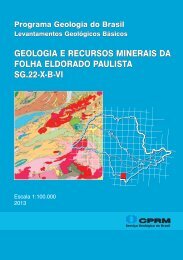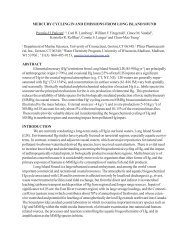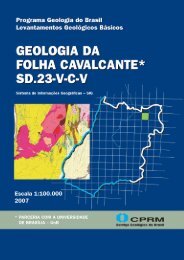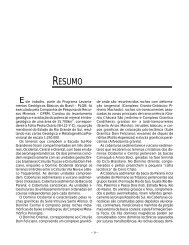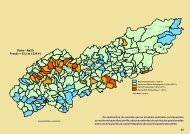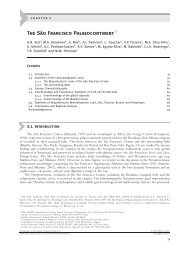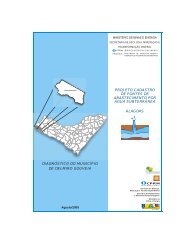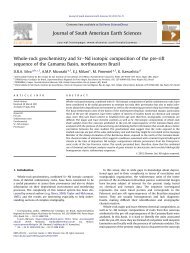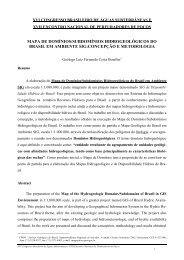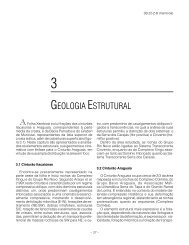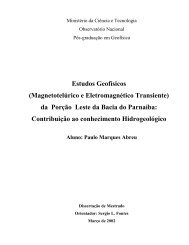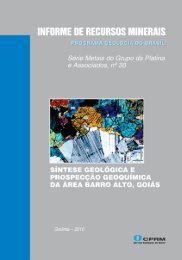Origin of the CO2-only fluid inclusions in the ... - CPRM
Origin of the CO2-only fluid inclusions in the ... - CPRM
Origin of the CO2-only fluid inclusions in the ... - CPRM
Create successful ePaper yourself
Turn your PDF publications into a flip-book with our unique Google optimized e-Paper software.
38 E.L. Kle<strong>in</strong>, K. Fuzikawa / Ore Geology Reviews 37 (2010) 31–40<br />
value <strong>of</strong> <strong>the</strong> late barren quartz ve<strong>in</strong>let is ra<strong>the</strong>r different. The source <strong>of</strong><br />
this lighter carbon rema<strong>in</strong>s unknown, but contribution <strong>of</strong> organic carbon<br />
<strong>in</strong> shallower levels <strong>of</strong> <strong>the</strong> crust is a possible explanation.<br />
Thepresence<strong>of</strong>C 2H 6 and o<strong>the</strong>r light hydrocarbons <strong>in</strong> <strong>fluid</strong> <strong><strong>in</strong>clusions</strong><br />
from gold–quartz ve<strong>in</strong> deposits has been documented <strong>in</strong> a few cases <strong>in</strong> <strong>the</strong><br />
Canadian Abitibi belt (Graney and Kesler, 1995), <strong>in</strong> <strong>the</strong> Barberton<br />
greenstone belt <strong>of</strong> South Africa (Bray et al., 1991; De Ronde et al., 1992),<br />
and <strong>in</strong> <strong>the</strong> Yilgarn block <strong>of</strong> Western Australia (Polito et al., 2001). In <strong>the</strong><br />
latter case, <strong>the</strong> source <strong>of</strong> <strong>the</strong>se hydrocarbons appears to be a reduction <strong>of</strong><br />
<strong>CO2</strong> to CH4 and C2H6.<br />
7.3. Trapp<strong>in</strong>g conditions<br />
Despite <strong>the</strong> similar composition with<strong>in</strong> <strong>the</strong> m<strong>in</strong>eralised ve<strong>in</strong>s, differences<br />
<strong>in</strong> <strong>the</strong> evolution and/or trapp<strong>in</strong>g conditions <strong>of</strong> <strong>the</strong> carbonic <strong>fluid</strong><br />
at Carará are <strong>in</strong>dicated by large variations <strong>in</strong> Th<strong>CO2</strong> (Fig. 6B), i.e., <strong>in</strong> <strong>the</strong><br />
density <strong>of</strong> <strong>the</strong> carbonic <strong>fluid</strong>. This large density range may be expla<strong>in</strong>ed<br />
by different processes that <strong>in</strong>clude trapp<strong>in</strong>g <strong>of</strong> <strong>fluid</strong>s with decreas<strong>in</strong>g<br />
density; trapp<strong>in</strong>g <strong>of</strong> <strong>fluid</strong> under fluctuat<strong>in</strong>g <strong>fluid</strong> pressure; re-equilibration<br />
under retrogressive conditions dur<strong>in</strong>g uplift; water leakage or a<br />
comb<strong>in</strong>ation <strong>of</strong> <strong>the</strong>se.<br />
The statistical evaluation <strong>of</strong> micro<strong>the</strong>rmometric data shows that,<br />
at least for <strong>the</strong> high-grade quartz, <strong>the</strong> global variation <strong>in</strong> T hCO 2 values<br />
(−28.5 to 12.9 °C), <strong>the</strong> moderate standard deviation (7.5 °C), <strong>the</strong><br />
absence <strong>of</strong> correlation between <strong>in</strong>clusion size and T hCO 2 (Fig. 7A), and<br />
<strong>the</strong> shape <strong>of</strong> <strong>the</strong> histogram, skewed to <strong>the</strong> right (Fig. 6B), strongly<br />
<strong>in</strong>dicate density re-equilibration dur<strong>in</strong>g deformation under plastic<br />
regime, at high temperature and low stra<strong>in</strong> rate, accord<strong>in</strong>g to <strong>the</strong><br />
criteria <strong>of</strong> Vityk and Bodnar (1998). In this case, <strong>the</strong> average T hCO 2<br />
(−0.5 °C) represents <strong>the</strong> <strong>in</strong>ternal overpressure that could have been<br />
ma<strong>in</strong>ta<strong>in</strong>ed for most <strong>of</strong> <strong>the</strong> re-equilibrated <strong>fluid</strong> <strong><strong>in</strong>clusions</strong> (Fig. 8).<br />
Fur<strong>the</strong>rmore, <strong>the</strong> isochore that represents <strong>the</strong> average Th<strong>CO2</strong> is compatible<br />
with <strong>the</strong> geo<strong>the</strong>rmal gradient <strong>in</strong>ferred for <strong>the</strong> area (Fig. 8).<br />
Moreover, <strong>the</strong> <strong><strong>in</strong>clusions</strong> show<strong>in</strong>g <strong>the</strong> highest densities likely represent<br />
<strong>the</strong> closest composition <strong>of</strong> <strong>the</strong> parental deeply-sourced <strong>fluid</strong>.<br />
The low-grade quartz appears to have trapped <strong>only</strong> <strong>the</strong> re-equilibrated<br />
<strong>fluid</strong>, because <strong>the</strong> isochore <strong>of</strong> highest density <strong>of</strong> this quartz equals <strong>the</strong><br />
isochore <strong>of</strong> average Th<strong>CO2</strong> <strong>of</strong> <strong>the</strong> high-grade quartz. In addition, <strong>the</strong><br />
positive correlation between <strong>in</strong>clusion size and T hCO 2 (Fig. 7B) and <strong>the</strong><br />
poorly def<strong>in</strong>ed multimodal histogram (Fig. 6B) may <strong>in</strong>dicate brittle<br />
deformation (Touret, 1994; Vityk and Bodnar, 1998).<br />
For <strong>the</strong> two-phase aqueous-carbonic <strong>fluid</strong> <strong><strong>in</strong>clusions</strong> <strong>of</strong> <strong>the</strong> late<br />
barren quartz ve<strong>in</strong>let, <strong>the</strong> homogenisation temperatures vary between<br />
264 and 346 °C. Isochores calculated for <strong>the</strong>se <strong><strong>in</strong>clusions</strong> <strong>in</strong>tercept <strong>the</strong><br />
solvus <strong>of</strong> <strong>the</strong> <strong>CO2</strong>–H2O–NaCl chemical system at 280 to 286 °C and 1.6 to<br />
2.0 kbar (Fig. 8). These are considered m<strong>in</strong>imum (or f<strong>in</strong>al) trapp<strong>in</strong>g<br />
conditions for <strong>the</strong> m<strong>in</strong>eralised ve<strong>in</strong>s. Kle<strong>in</strong>etal.(<strong>in</strong>press)reported<br />
temperatures <strong>of</strong> 475 and 447 °C for Carará and <strong>the</strong> nearby (and<br />
geologically similar) Catar<strong>in</strong>o show<strong>in</strong>g, respectively, based on oxygen<br />
isotope fractionation between hydro<strong>the</strong>rmal quartz and muscovite.<br />
These temperatures lie close to <strong>the</strong> upper limit <strong>of</strong> <strong>the</strong> retrogressive,<br />
greenschist facies metamorphic event established by Faraco et al. (2006)<br />
and likely represent <strong>the</strong> conditions <strong>of</strong> <strong>the</strong> hydrous alteration.<br />
It is, however, likely that a hot, high density CO 2-rich <strong>fluid</strong> started<br />
to be trapped at amphibolite facies or higher conditions and became<br />
progressively re-equilibrated under retrogressive conditions. The<br />
ma<strong>in</strong> entrapment occurred at conditions that surround <strong>the</strong> average<br />
isochore and a P–T w<strong>in</strong>dow (Fig. 8) may be limited by <strong>the</strong> <strong>in</strong>tersection<br />
<strong>of</strong> <strong>the</strong> maximum homogenisation temperature <strong>of</strong> <strong>the</strong> aqueous-carbonic<br />
<strong>fluid</strong> <strong><strong>in</strong>clusions</strong> <strong>of</strong> <strong>the</strong> late quartz-tourmal<strong>in</strong>e ve<strong>in</strong>let and <strong>the</strong><br />
temperature yielded by <strong>the</strong> quartz–muscovite pair with <strong>the</strong> lowest<br />
isochore <strong>of</strong> <strong>the</strong> high-grade quartz <strong>fluid</strong> <strong><strong>in</strong>clusions</strong> and <strong>the</strong> geo<strong>the</strong>rmal<br />
gradient. This implies 350 to 475 °C, 1.8 to 3.6 kbar and 7 to 12 km<br />
depth for ve<strong>in</strong> formation, hydro<strong>the</strong>rmal alteration and gold m<strong>in</strong>eralisation.<br />
The isochore <strong>of</strong> <strong>the</strong> highest density approximates <strong>the</strong><br />
parental <strong>fluid</strong> conditions and <strong>the</strong> large pressure variation is consistent<br />
with <strong>the</strong> active structural environment described for <strong>the</strong> deposit.<br />
7.4. The role <strong>of</strong> CO 2 <strong>in</strong> ore formation<br />
Despite <strong>the</strong> ubiquitous association <strong>of</strong> CO 2 with hydro<strong>the</strong>rmal ore<br />
deposits, little is known about <strong>the</strong> role <strong>of</strong> <strong>CO2</strong> as a ligand or its direct<br />
participation <strong>in</strong> ore formation. Few studies provide any <strong>in</strong>dication <strong>of</strong> metal<br />
mobilization by this volatile (e.g., Higg<strong>in</strong>s, 1980; Keppler and Wyllie,<br />
1990). The ma<strong>in</strong> arguments used aga<strong>in</strong>st an orig<strong>in</strong>al CO 2-rich <strong>fluid</strong> and a<br />
direct role <strong>in</strong> gold transport are: (1) wall-rock alteration, generally enriched<br />
<strong>in</strong> hydrous phases, requires <strong>the</strong> presence <strong>of</strong> an aqueous <strong>fluid</strong>; (2)<br />
<strong>the</strong> limited solubility <strong>of</strong> <strong>CO2</strong> <strong>in</strong> silicate melts (e.g., Wal<strong>the</strong>r and Orville,<br />
1983); (3) <strong>the</strong> scarcity <strong>of</strong> constra<strong>in</strong>ts on <strong>the</strong> solubility <strong>of</strong> metals <strong>in</strong> CO 2<br />
(Ridley and Diamond, 2000); (4) <strong>the</strong> weak chemical bond<strong>in</strong>g between<br />
gold ions and CO 2 species (Phillips and Evans, 2004); and (5) <strong>the</strong> more<br />
accepted transport <strong>of</strong> gold as hydrosulphide or chloride complexes,<br />
<strong>in</strong>stead <strong>of</strong> by a CO 2-rich <strong>fluid</strong> (e.g., Romberger, 1990; Seward, 1991).<br />
Lowenstern (2001) stressed that a possible explanation for this discrepant<br />
behaviour is that CO 2 is a very common gas <strong>in</strong> magmatic and o<strong>the</strong>r<br />
hydro<strong>the</strong>rmal systems and, thus, it should be ubiquitous.<br />
Possibly, CO 2 plays an <strong>in</strong>direct role <strong>in</strong> gold transport. For <strong>in</strong>stance, CO 2<br />
facilitates unmix<strong>in</strong>g and creation <strong>of</strong> a separate vapour phase, which, <strong>in</strong><br />
turn, might move sulphur and chlor<strong>in</strong>e species to <strong>the</strong> vapour and act as<br />
ligands for metals. At <strong>the</strong> same time, phase separation will change o<strong>the</strong>r<br />
physico-chemical properties <strong>of</strong> <strong>the</strong> <strong>fluid</strong>, such as P<strong>CO2</strong> and pH, caus<strong>in</strong>g<br />
destabilization <strong>of</strong> metal-transport<strong>in</strong>g complexes and, consequently, ore<br />
precipitation. Therefore, <strong>CO2</strong> would act at least on <strong>the</strong> creation and<br />
evolution <strong>of</strong> metal-bear<strong>in</strong>g vapours (Lowenstern, 2001). Fur<strong>the</strong>rmore,<br />
Phillips and Evans (2004) proposed that <strong>CO2</strong>, as a weak acid, might help<br />
gold transport by buffer<strong>in</strong>g <strong>the</strong> <strong>fluid</strong> <strong>in</strong> a pH range where high gold<br />
Fig. 7. Diagrams show<strong>in</strong>g <strong>the</strong> relationships between homogenisation temperature (T hCO 2) and <strong>in</strong>clusion size for <strong>fluid</strong> <strong><strong>in</strong>clusions</strong> from <strong>the</strong> high-grade quartz (A) and low-grade<br />
quartz (B). The dashed arrow <strong>in</strong> B <strong>in</strong>dicates <strong>the</strong> positive correlation between <strong>the</strong> compared properties.



